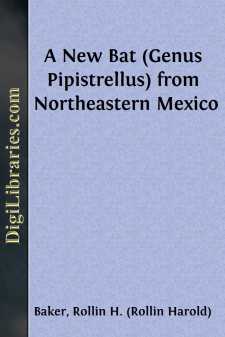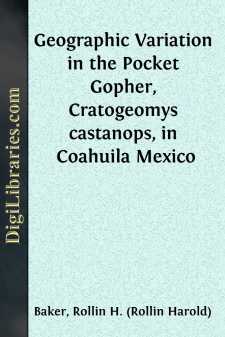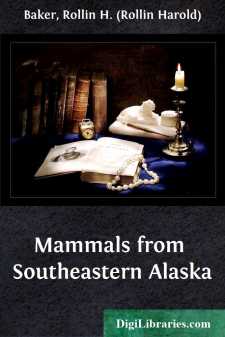Categories
- Antiques & Collectibles 13
- Architecture 36
- Art 48
- Bibles 22
- Biography & Autobiography 813
- Body, Mind & Spirit 142
- Business & Economics 28
- Children's Books 17
- Children's Fiction 14
- Computers 4
- Cooking 94
- Crafts & Hobbies 4
- Drama 346
- Education 46
- Family & Relationships 57
- Fiction 11829
- Games 19
- Gardening 17
- Health & Fitness 34
- History 1377
- House & Home 1
- Humor 147
- Juvenile Fiction 1873
- Juvenile Nonfiction 202
- Language Arts & Disciplines 88
- Law 16
- Literary Collections 686
- Literary Criticism 179
- Mathematics 13
- Medical 41
- Music 40
- Nature 179
- Non-Classifiable 1768
- Performing Arts 7
- Periodicals 1453
- Philosophy 64
- Photography 2
- Poetry 896
- Political Science 203
- Psychology 42
- Reference 154
- Religion 513
- Science 126
- Self-Help 84
- Social Science 81
- Sports & Recreation 34
- Study Aids 3
- Technology & Engineering 59
- Transportation 23
- Travel 463
- True Crime 29
A New Bat (Genus Pipistrellus) from Northeastern Mexico
Description:
Excerpt
The eastern pipistrelle, Pipistrellus subflavus (Cuvier) in the western part of its range, occurs along the RÃo Grande and its tributaries as far west as northern Coahuila and Val Verde County, Texas. Specimens from those places represent a heretofore undescribed subspecies which may be named and described as follows:
Type.—Female, adult, skin and skull; No. 48270, Univ. Kansas Mus. Nat. Hist.; 2 mi. W Jiménez, el. 850 ft., Coahuila; 19 June 1952; obtained by Rollin H. Baker, original No. 2062.
Range.—Known from northern Coahuila and adjacent parts of southwestern Texas.
Diagnosis.—Size large (see measurements); upper parts pale, near (c) Cinnamon-Buff (capitalized color term after Ridgway, Color Standards and Color Nomenclature, Washington, D. C., 1912); skull large; zygomata expanded laterally.
Comparisons.—Compared with Pipistrellus subflavus subflavus (specimens from Marshall Hall in Maryland, Raleigh in North Carolina, and Barber County in Kansas) P. s. clarus is paler, of approximately equal size, and has the zygomata slightly more expanded laterally. From Pipistrellus subflavus veracrucis (Ward), specimens from 4 km. E Las Vigas, el. 8500 ft., Veracruz, P. s. clarus differs in being larger, paler, and in having a larger skull.
Remarks.—Pipistrellus subflavus clarus is the palest subspecies of the eastern pipistrelle. Of the specimens assigned to clarus (all taken in May and June), only two are sufficiently dark to compare favorably with examples of typical subflavus. A specimen (KU 60296) assigned to P. s. subflavus from Rancho Pano Ayuctle, el. 300 ft., 6 mi. N Gómez FarÃas, Tamaulipas, is much darker than clarus. A specimen recorded from Devils River, Texas, by V. Bailey (N. Amer. Fauna, 25:211, October 24, 1905) has not been examined by me but presumably is P. s. clarus.
Pipistrellus subflavus clarus was taken along the RÃo San Diego and the RÃo Sabinas, both tributaries of the RÃo Grande, where park-like stands of pecan, cypress, willow and other trees bordered these streams. The species was not found at stock ponds or along stream courses in adjacent places where such trees were absent. Funds for financing field work were made available by the Kansas University Endowment Association and the National Science Foundation.
Measurements.—Measurements of the holotype and average and extreme measurements of 5 adult females from the type locality, including the holotype, are, respectively, as follows: Total length, 85, 88.0 (85-92); length of tail vertebrae, 43, 40.8 (36-45); length of hind foot, 9, 9.4 (8.5-11); height of ear from notch, 12, 12.6 (12-13); length of forearm, 33.8, 33.4 (32.9-33.8); length of tibia, 14.8, 14.6 (14.5-14.8); greatest length of skull, 13.3, 13.1 (12.7-13.3); condylobasal length, 12.6, 12.4 (12.1-12.6); breadth of braincase, 7.0, 6.8 (6.7-7.0); zygomatic breadth, 8.1, 8.0 (7.8-8.2); mastoid breadth, 7.1, 6.9 (6.5-7.1); length maxillary tooth-row, 4.5, 4.5 (4.4-4.6).
Specimens examined.—Those from Texas are in the collection of the United States National Museum, and those from Coahuila are in University of Kansas Museum of Natural History. Total, 21. Texas: Comstock, 1; Del Rio, 2. Coahuila: 2 mi. W Jiménez, 850 ft., 15; 2 mi. S and 3 mi. E San Juan de Sabinas, 1160 ft., 3....









